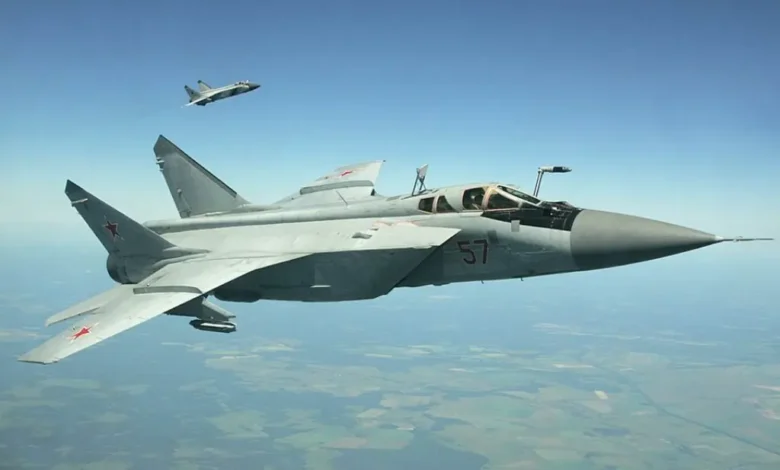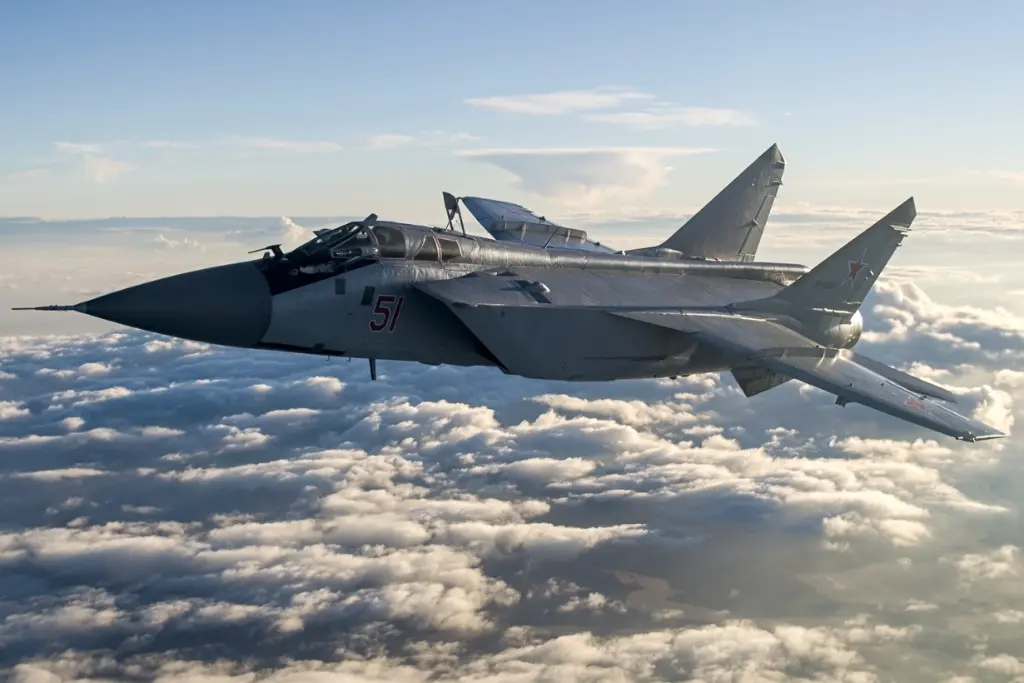Mikoyan MiG-31

The Mikoyan MiG-31, also known as “Foxhound” by NATO, is a supersonic interceptor aircraft developed by Mikoyan for the Soviet Air Force. First flown in 1975 and introduced in 1981, the MiG-31 was designed to replace the MiG-25 and intercept high-speed, high-altitude targets. Known for its exceptional speed, range, and advanced radar systems, the MiG-31 remains a critical component of Russia’s air defense network.
Fact Sheet
| Role | Interceptor |
|---|---|
| Manufacturer | Mikoyan |
| First Flight | 1975 |
| Service Entry | 1981 |
| Crew | 2 (pilot and weapons systems officer) |
Specifications
| Length | 22.69 m (74 ft 5 in) |
|---|---|
| Wingspan | 13.46 m (44 ft 2 in) |
| Height | 6.15 m (20 ft 2 in) |
| Empty Weight | 21,820 kg (48,120 lb) |
| Max Takeoff Weight | 46,200 kg (101,900 lb) |
| Powerplant | 2 × Soloviev D-30F6 turbofans |
| Thrust | 34,170 lbf (152 kN) per engine with afterburner |
| Max Speed | Mach 2.83 (3,000 km/h; 1,864 mph) |
| Service Ceiling | 20,600 m (67,600 ft) |
| Range | 1,450 mi (2,335 km) combat radius |
| Rate of Climb | ~65,000 ft/min (330 m/s) |
Avionics & Armament
| Main Radar | Zaslon-M PESA radar |
|---|---|
| Avionics | Advanced radar and electronic warfare systems |
| Armament | One 23-mm GSh-6-23M cannon (260 rounds); Up to 6 external hardpoints for: – Air-to-air missiles (R-33, R-37, R-77) – External fuel tanks |
Notable Features
- Exceptional speed for intercepting high-speed targets.
- Advanced radar capable of tracking multiple targets simultaneously.
- Long range for extended patrol missions.
- High-altitude capability for intercepting strategic bombers and reconnaissance aircraft.
- Still in service with the Russian Air Force and modernized variants in development.

The Mikoyan MiG-31 (NATO reporting name: Foxhound) is a formidable supersonic interceptor aircraft developed for the Soviet Air Forces by the Mikoyan design bureau. It was conceived in the 1970s as a direct replacement for the earlier MiG-25 “Foxbat,” designed to overcome its predecessor’s limitations, particularly its poor low-altitude performance and comparatively less advanced radar. The MiG-31 is a highly specialized aircraft, optimized for its role of long-range interception and air defense of vast territories.
It officially entered service with the Soviet Air Forces in 1981 (or 1982, depending on the source) and remains a critical asset for Russia and Kazakhstan. The MiG-31 is expected to stay in service with Russian and Kazakh forces until at least 2030 or later.
Development and Purpose
The primary motivation behind the MiG-31’s development was the need for an interceptor that could effectively counter threats like low-flying cruise missiles and strategic bombers, which the MiG-25 struggled against at lower altitudes. The MiG-31’s design was based on the MiG-25 but featured significant improvements:
- Two-Seat Cockpit: Unlike the single-seat MiG-25, the MiG-31 is a two-seater, with a pilot in the front and a dedicated Weapon Systems Officer (WSO) in the rear. This division of labor is crucial for managing the complex radar and weapon systems during long-range intercept missions.
- Stronger Airframe: The MiG-31’s airframe is composed of a more robust mix of materials, including a higher percentage of arc-welded nickel steel (49%), light metal alloy (33%), titanium (16%), and composites (2%). This stronger construction allows for sustained supersonic flight even at low altitudes, unlike the MiG-25, which risked engine damage at high speeds in dense low-altitude air.
- Powerful Engines: It is powered by two Soloviev D-30F6 afterburning turbofan engines. These engines provide significant thrust, allowing the MiG-31 to reach speeds of up to Mach 2.83 (around 3,000 km/h or 1,900 mph) at high altitude and Mach 1.23 (1,500 km/h) at low altitude. Its supersonic range is primarily limited by fuel capacity, not airframe constraints.
The Groundbreaking N007 Zaslon Radar
A defining feature of the MiG-31, and a revolutionary advancement for its time, is its N007 Zaslon passive electronically scanned array (PESA) radar.
- First PESA on a Fighter: The Zaslon was the world’s first phased array radar to be installed on a fighter aircraft, publicly unveiled at the 1991 Paris Airshow. This technology allowed for near-instantaneous beam steering, a significant advantage over the slow mechanical scanning of older radars.
- Look-Down/Shoot-Down Capability: The Zaslon provided true look-down/shoot-down capability, meaning it could effectively detect and track small, low-flying targets like cruise missiles against the cluttered backdrop of ground radar returns.
- Multi-Target Engagement: The original Zaslon could track up to 10 targets simultaneously and engage 4 of them at once with its long-range air-to-air missiles. This capability was matched in the West only by the F-14 Tomcat and its AWG-9 radar/AIM-54 Phoenix combination.
- Network-Centric Warfare: The MiG-31 was ahead of its time with its APD-518 datalink. A flight of four MiG-31s could establish a coordinated patrol line 800-900 km wide, automatically sharing target data. One MiG-31 could act as a “mini-AWACS,” guiding missiles from other fighters (including Su-27s or MiG-29s) whose own radars remained off, providing a massive tactical advantage.
Armament
The MiG-31 is armed primarily with long-range air-to-air missiles for its interceptor role:
- R-33 (AA-9 Amos): Its primary weapon, capable of hitting targets up to 120-160 km away. Four of these are typically carried under the fuselage.
- R-37M (AA-13 Axehead): For upgraded variants like the MiG-31BM, the R-37M is the main long-range missile, with a reported range of over 300 km.
- Other Missiles: It also has four underwing hardpoints for shorter-range missiles like the R-40 (AA-6 Acrid) and R-60 (AA-8 Aphid). Later variants can also carry the R-77 (RVV-AE) medium-range missile.
- Internal Cannon: Unlike its predecessor, the MiG-31 includes a 23mm GSh-6-23 six-barrel rotary cannon in the starboard wing root for close-in engagements.
The MiG-31BM Modernization
The most significant upgrade variant is the MiG-31BM (Bolshaya Modernizatsiya, “Deep Modernization” or “Big Modernization”). This program began in 2010 to extend the service life and enhance the capabilities of the existing MiG-31 fleet. The MiG-31BM features:
- Upgraded Zaslon-M Radar: A larger antenna (1.4 meters in diameter) and significantly increased detection range (reportedly up to 320 km for fighter-sized targets and 400 km for bomber-sized targets or AWACS). It can track 24 targets simultaneously and engage 8 of them at once. It also provides improved ground mapping and multi-mode capabilities.
- Multi-Role Capability: The MiG-31BM gains the ability to carry and launch air-to-surface weapons, including precision-guided bombs and anti-radiation missiles, giving it a secondary strike role.
- New Avionics: Updated “glass cockpit” elements with liquid crystal displays (LCD MFDs), Hands-On-Throttle-And-Stick (HOTAS) controls, and improved communication and electronic warfare systems.
- R-37M Integration: The MiG-31BM’s primary long-range armament is the highly capable R-37M missile.
- Kinzhal Hypersonic Missile Carrier: Critically, the MiG-31K variant (derived from the BM) is modified to carry and launch the Kh-47M2 Kinzhal air-launched ballistic missile, a nuclear-capable hypersonic weapon. This gives the MiG-31 a strategic strike role.
Current Operators and Combat Record
The primary operators of the MiG-31 are:
- Russia (Russian Aerospace Forces): Operating around 315 MiG-31s, with a significant number upgraded to the MiG-31BM/BSM standard. These aircraft are crucial for air defense across Russia’s vast territory.
- Kazakhstan: Operates around 34 MiG-31s, largely inherited from the Soviet Union.
The MiG-31 has seen combat, notably in the ongoing Russo-Ukrainian War:
- Anti-Air Operations: Russian MiG-31s, particularly the BM variant, have reportedly been effective in shooting down Ukrainian aircraft, mostly with the long-range R-37M air-to-air missile. Ukraine lacks aircraft that can match the MiG-31’s speed, altitude, or its long-range radar and missile combination, making them difficult to counter.
- Kinzhal Launches: MiG-31K variants have been used to launch Kinzhal hypersonic missiles against targets in Ukraine, demonstrating their strategic strike capability.
- Losses: While generally operating from relatively safe distances, there have been some reported losses of MiG-31s in the conflict (including some unconfirmed reports of a MiG-31 being shot down by Ukrainian forces).
The MiG-31 “Foxhound” remains a unique and vital asset, particularly for Russia’s air defense strategy. Its unparalleled speed, long range, powerful radar, and formidable long-range missile capabilities (further enhanced by the BM upgrade and Kinzhal integration) ensure its continued relevance as a strategic interceptor and, increasingly, a tactical strike platform in the 21st century.



